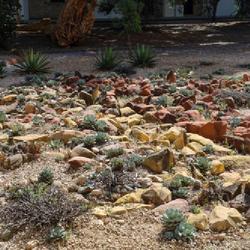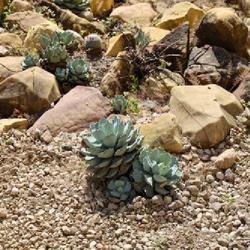General Plant Information (Edit)
| Plant Habit: |
Cactus/Succulent
|
| Life cycle: |
Perennial
|
| Sun Requirements: |
Full Sun
|
| Leaves: |
Evergreen
|
| Fruit: |
Dehiscent
|
| Flowers: |
Showy
|
| Suitable Locations: |
Xeriscapic
|
| Uses: |
Will Naturalize
|
| Resistances: |
Deer Resistant
|
| Toxicity: |
Other: The juice from many species of agave can cause acute contact dermatitis that produces reddening and blistering lasting approximately one to two weeks. Itching may recur up to a year later without a visible rash. Dried parts of the plants can be handled sa
|
| Propagation: Seeds: |
Can handle transplanting
Other info: Sow in shallow pots with a well draining, sterile mix; 50/50 organic/inorganic of coarse perlite, pumice; sphagnum peat or good compost. Avoid manures. Irrigate from below by submerging in water to 1/2 height of pot. Provide bright, indirect light and a
|
| Propagation: Other methods: |
Cuttings: Stem
Offsets
Other: Bulbils
|
| Containers: |
Needs excellent drainage in pots
|
| Miscellaneous: |
With thorns/spines/prickles/teeth
Monocarpic
|
- Dwarf Butterfly Agave
- Maguey Istmeño
- Century Plant
- Maguey
Posted by
Baja_Costero (Baja California - Zone 11b) on Jul 10, 2023 5:24 PM concerning plant:
Small, offsetting glaucous blue agave from the Isthmus of Tehuantepec in far southern Mexico. Rosettes may grow up to 10-14 inches wide but are often smaller. They usually offset via rhizomes (early in life) and/or via axillary branching (later in life). Leaves have a rough texture, with undulating, crenate margins. They have small, sharp teeth and terminal spines.
This species (described in 1993) is found in Oaxaca and Chiapas. It is related to Agave potatorum, found further to the north in Puebla and Oaxaca. Agave potatorum is typically a larger plant and much less prone to offsetting. Various cultivars of isthmensis are found in cultivation, including the unusual dwarf cultivar 'Shoji Raijin' (rosettes to about 5", clumps to about 8") and its many variegated derivatives.
Best form and color in strong light. A great candidate for containers because of its limited size and chunky, sculptural leaves. Also a great candidate for a mass planting in the landscape. The common name dwarf butterfly agave refers to its bigger cousin, the butterfly agave (potatorum). That common name is a translation of the Nahuatl word papalometl.
| Thread Title |
Last Reply |
Replies |
| ID question by Baja_Costero |
Feb 22, 2023 11:23 AM |
0 |
« Add a new plant to the database
» Search the Agaves Database: by characteristics or by cultivar name
« See the general plant entry for Agaves (Agave)
« The Agaves Database Front Page
« The Plants Database Front Page





